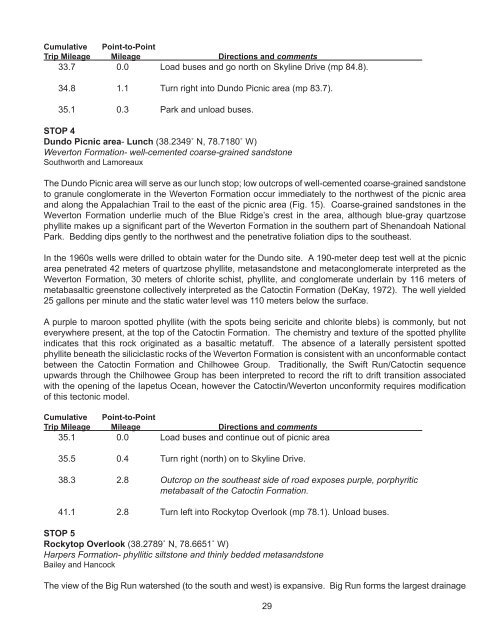Geology of the Shenandoah National Park Region - Csmres Jmu ...
Geology of the Shenandoah National Park Region - Csmres Jmu ...
Geology of the Shenandoah National Park Region - Csmres Jmu ...
Create successful ePaper yourself
Turn your PDF publications into a flip-book with our unique Google optimized e-Paper software.
Cumulative Point-to-Point<br />
Trip Mileage Mileage Directions and comments<br />
33.7 0.0 Load buses and go north on Skyline Drive (mp 84.8).<br />
34.8 1.1 Turn right into Dundo Picnic area (mp 83.7).<br />
35.1 0.3 <strong>Park</strong> and unload buses.<br />
STOP 4<br />
Dundo Picnic area- Lunch (38.2349˚ N, 78.7180˚ W)<br />
Weverton Formation- well-cemented coarse-grained sandstone<br />
Southworth and Lamoreaux<br />
The Dundo Picnic area will serve as our lunch stop; low outcrops <strong>of</strong> well-cemented coarse-grained sandstone<br />
to granule conglomerate in <strong>the</strong> Weverton Formation occur immediately to <strong>the</strong> northwest <strong>of</strong> <strong>the</strong> picnic area<br />
and along <strong>the</strong> Appalachian Trail to <strong>the</strong> east <strong>of</strong> <strong>the</strong> picnic area (Fig. 15). Coarse-grained sandstones in <strong>the</strong><br />
Weverton Formation underlie much <strong>of</strong> <strong>the</strong> Blue Ridge’s crest in <strong>the</strong> area, although blue-gray quartzose<br />
phyllite makes up a significant part <strong>of</strong> <strong>the</strong> Weverton Formation in <strong>the</strong> sou<strong>the</strong>rn part <strong>of</strong> <strong>Shenandoah</strong> <strong>National</strong><br />
<strong>Park</strong>. Bedding dips gently to <strong>the</strong> northwest and <strong>the</strong> penetrative foliation dips to <strong>the</strong> sou<strong>the</strong>ast.<br />
In <strong>the</strong> 1960s wells were drilled to obtain water for <strong>the</strong> Dundo site. A 190-meter deep test well at <strong>the</strong> picnic<br />
area penetrated 42 meters <strong>of</strong> quartzose phyllite, metasandstone and metaconglomerate interpreted as <strong>the</strong><br />
Weverton Formation, 30 meters <strong>of</strong> chlorite schist, phyllite, and conglomerate underlain by 116 meters <strong>of</strong><br />
metabasaltic greenstone collectively interpreted as <strong>the</strong> Catoctin Formation (DeKay, 1972). The well yielded<br />
25 gallons per minute and <strong>the</strong> static water level was 110 meters below <strong>the</strong> surface.<br />
A purple to maroon spotted phyllite (with <strong>the</strong> spots being sericite and chlorite blebs) is commonly, but not<br />
everywhere present, at <strong>the</strong> top <strong>of</strong> <strong>the</strong> Catoctin Formation. The chemistry and texture <strong>of</strong> <strong>the</strong> spotted phyllite<br />
indicates that this rock originated as a basaltic metatuff. The absence <strong>of</strong> a laterally persistent spotted<br />
phyllite beneath <strong>the</strong> siliciclastic rocks <strong>of</strong> <strong>the</strong> Weverton Formation is consistent with an unconformable contact<br />
between <strong>the</strong> Catoctin Formation and Chilhowee Group. Traditionally, <strong>the</strong> Swift Run/Catoctin sequence<br />
upwards through <strong>the</strong> Chilhowee Group has been interpreted to record <strong>the</strong> rift to drift transition associated<br />
with <strong>the</strong> opening <strong>of</strong> <strong>the</strong> Iapetus Ocean, however <strong>the</strong> Catoctin/Weverton unconformity requires modification<br />
<strong>of</strong> this tectonic model.<br />
Cumulative Point-to-Point<br />
Trip Mileage Mileage Directions and comments<br />
35.1 0.0 Load buses and continue out <strong>of</strong> picnic area<br />
35.5 0.4 Turn right (north) on to Skyline Drive.<br />
38.3 2.8 Outcrop on <strong>the</strong> sou<strong>the</strong>ast side <strong>of</strong> road exposes purple, porphyritic<br />
metabasalt <strong>of</strong> <strong>the</strong> Catoctin Formation.<br />
41.1 2.8 Turn left into Rockytop Overlook (mp 78.1). Unload buses.<br />
STOP 5<br />
Rockytop Overlook (38.2789˚ N, 78.6651˚ W)<br />
Harpers Formation- phyllitic siltstone and thinly bedded metasandstone<br />
Bailey and Hancock<br />
The view <strong>of</strong> <strong>the</strong> Big Run watershed (to <strong>the</strong> south and west) is expansive. Big Run forms <strong>the</strong> largest drainage<br />
29


